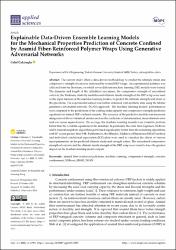| dc.contributor.author | Çakıroğlu, Celal | |
| dc.date.accessioned | 2024-04-04T18:42:04Z | |
| dc.date.available | 2024-04-04T18:42:04Z | |
| dc.date.issued | 2023 | en_US |
| dc.identifier.citation | Çakıroğlu, C. (2023). Explainable data-driven ensemble learning models for the mechanical properties prediction of concrete confined by aramid fiber-reinforced polymer wraps using generative adversarial networks. MDPI AG, 13 (21). | en_US |
| dc.identifier.uri | https://hdl.handle.net/20.500.12846/1031 | |
| dc.description.abstract | : The current study offers a data-driven methodology to predict the ultimate strain and
compressive strength of concrete reinforced by aramid FRP wraps. An experimental database was
collected from the literature, on which seven different machine learning (ML) models were trained.
The diameter and length of the cylindrical specimens, the compressive strength of unconfined
concrete, the thickness, elasticity modulus and ultimate tensile strength of the FRP wrap were used
as the input features of the machine learning models, to predict the ultimate strength and strain of
the specimens. The experimental dataset was further enhanced with synthetic data using the tabular
generative adversarial network (TGAN) approach. The machine learning models’ performances
were compared to the predictions of the existing strain capacity and compressive strength prediction
equations for aramid FRP-confined concrete. The accuracy of the predictive models was measured
using state-of-the-art statistical metrics such as the coefficient of determination, mean absolute error
and root mean squared error. On average, the machine learning models were found to perform
better than the available equations in the literature. In particular, the extra trees regressor, XGBoost
and K-nearest neighbors algorithms performed significantly better than the remaining algorithms,
with R
2
scores greater than 0.98. Furthermore, the SHapley Additive exPlanations (SHAP) method
and individual conditional expectation (ICE) plots were used to visualize the effects of various
input parameters on the predicted ultimate strain and strength values. The unconfined compressive
strength of concrete and the ultimate tensile strength of the FRP wrap were found to have the greatest
impact on the machine learning model outputs. | en_US |
| dc.language.iso | eng | en_US |
| dc.relation.isversionof | 10.3390/app132111991 | en_US |
| dc.rights | info:eu-repo/semantics/openAccess | en_US |
| dc.subject | Aramid fiber reinforced polymers | en_US |
| dc.subject | Machine learning | en_US |
| dc.subject | Compressive strength | en_US |
| dc.subject | Concrete confinement | en_US |
| dc.subject | XGBoost | en_US |
| dc.subject | SHAP | en_US |
| dc.subject | TGAN | en_US |
| dc.title | Explainable data-driven ensemble learning models for the mechanical properties prediction of concrete confined by aramid fiber-reinforced polymer wraps using generative adversarial networks | en_US |
| dc.type | article | en_US |
| dc.relation.journal | MDPI AG | en_US |
| dc.identifier.volume | 13 | en_US |
| dc.identifier.issue | 21 | en_US |
| dc.relation.publicationcategory | Makale - Uluslararası Hakemli Dergi - Kurum Öğretim Elemanı | en_US |
| dc.contributor.department | TAÜ, Mühendislik Fakültesi, İnşaat Mühendisliği Bölümü | en_US |

















